KWS Hybrid Rye- The new choice in feed production
Friday, February 7, 2025
Reference: Sponsored Article

The Power of KWS Hybrid Rye
KWS Hybrid Rye is a fall seeded, winter-hardy crop that boasts sound profitability while providing flexibility and risk management to your farming operation.

- Highest yielding cereal for grain and forage.
- Diversifies crop rotation.
- Improves workload management due to different planting and harvest dates.
- Protects valuable farmland from erosion in late fall, winter and early spring.
- breaks up pest cycles.
- Allelopathic massive root system.
- scavenges nitrogen and water from the soil.
- provides competition against weeds and reduces pesticide applications.
- provides drought resistance.
- breaks up hardpan and improces soil tilth.
- provides flexible end-use market opportinuties.
- can be harvested as grain for livestock feed, milling, distilling, ethanol and cover crop markets.
- can be harvested as forage for livestock feed.
- earliest maturing cereal forage, providing an opportunity to double crop in southern geographies.
- can be grazed in the fall and/or spring if pasture is needed.
KWS RyeGHT Seeding Practices
RyeGHT Rate and Time
The standard seeding rate is 1 unit/acre under good conditions for grain or forage use. To establish hybrid fall rye successfully, three weeks of good growing conditions are needed. Seeding rate decision factors include: moisture and heat units at seeding time, trash penetration, and seed row spacing. The suggested seeding rate and target shoot growth are as follows:
 *Please consult provincial crop insurance deadlines for insurable planting dates.
*Please consult provincial crop insurance deadlines for insurable planting dates.Fall is busy, and fall seeded crops require proactive planning. Select well drained fields that are free of residual herbicides. Know where you plan to seed your hybrid rye before seeding your spring crop, seed that spring crop early, and spread the trash evenly during harvest to limit residue issues. Have your drill cleaned and ready after spring seeding is complete.
RyeGHT Seed Placement:
Seed shallow at ¾" depth with a travel speed of <4.5 mph into a firm seed bed to maintain consistent seed depth. Seeding deeper or faster will result in higher seedling mortality and a reduced stand. Maintain a ¾" seed depth even if the soils is dry and wait for rain. Narrow row spacing of 6-7.5" is optimal for hybrid fall rye. If seeding on 10-12" spacing, speed, depth, and reate are more critical to elimiante skips and gaps in the field.
RyeGHT Stand:
The plant stand target is 16-18 plants/ft2 (grain) and 16-20 plants/ft2 (forage). Even emergence and achieving the target stand will provide the most consistent yields and the best resistance against ergot.
RyeGHT Pest Control:
To protect seedlings against diesease and insects, hybrid fall rye should be professionally treated with a registered seed tgreatment. A pre-plant or pre-emergent herbicide application is important to control weekds when the hybrid rye is the least competitive with most spring emerging weeds.
Hybrid Rye Grain for Pigs
KWS Hybrid Rye is a fall seeded, winter-hardy crop that boasts excellent nutritional value and beneficial attributes for pigs of all ages.
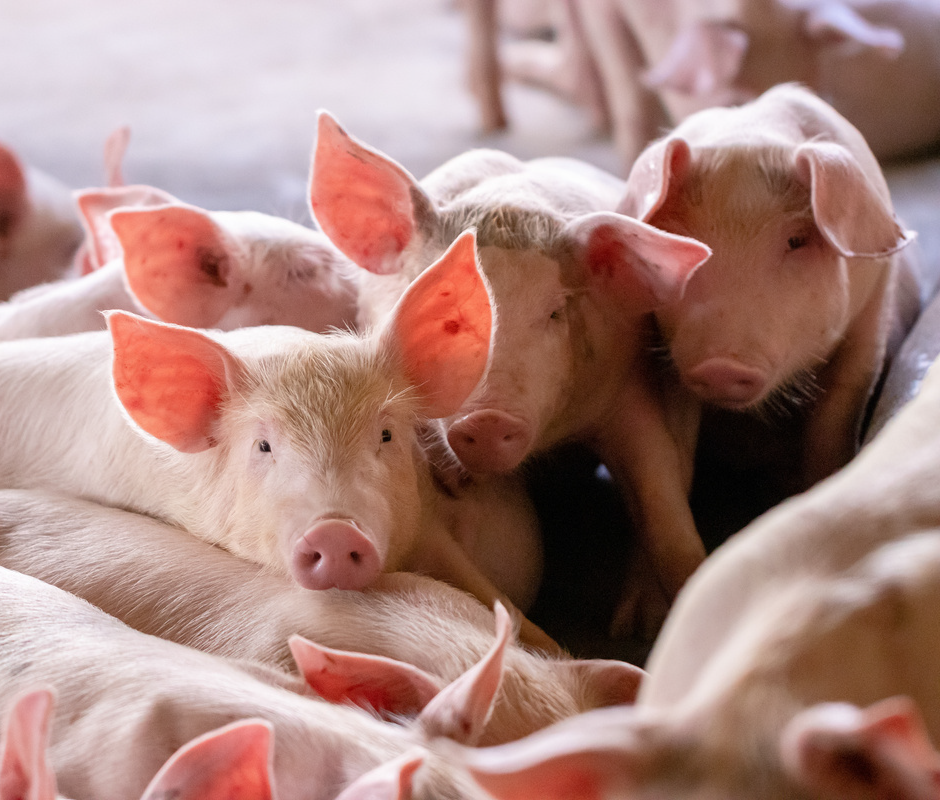
- Highest yielding cereal grain feeds more pigs per acre.
- average 30% more yield than conventional rye.
- High in energy, nutrient dense and highly digestible.
- excellent amino acid profile, including high levels of lysine and methionine.
- contains intrinsic phytase, improving the digestibility of phosphorus.
- Rich in high quality soluble fibres that promote animal health and well-being.
- Increased presence of beneficial bacteria can reduce pathogen binding in the intestine, leading to healthier pigs.
- Gut fill and soluble fibre digestion improves satiety, leading to calmer sows.
- Low iodine value product (IVP), making it an ideal choice for meat quality and firmness.
- Can be included into all stages of swine production.
- With a properly balanced ration, nursry and growing pigs have excellent feed intake, gains and feed efficiency.
*Assuming hybrid fall rye yields 40 more bu/acre than wheat grain, an additional 5 hogs (30 to 130kg live weight) could be fed per acre at 2200 kg cereal grain intake per hog." Smit et al., Canadian Hog Journal, Summer 2018.
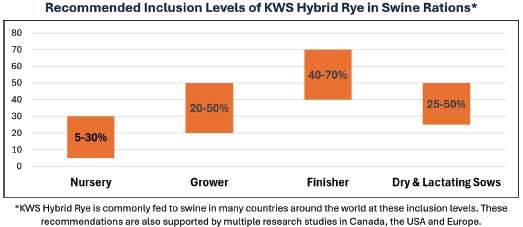
Early pollination and KWS PollenPLUS technology means that KWS Hybrid Rye is less susceptible to fusarium an dergot contaminationcompared to conventional rye and other cereal grains. It is always best practice to test your feed grains for mycotoxins before use. If myctoxins are present work with your nutritionist or KWS to manage feeding levels, especially in your breeding herd.
Average Nutrient Composition of KWS Hybrid Rye Grain1
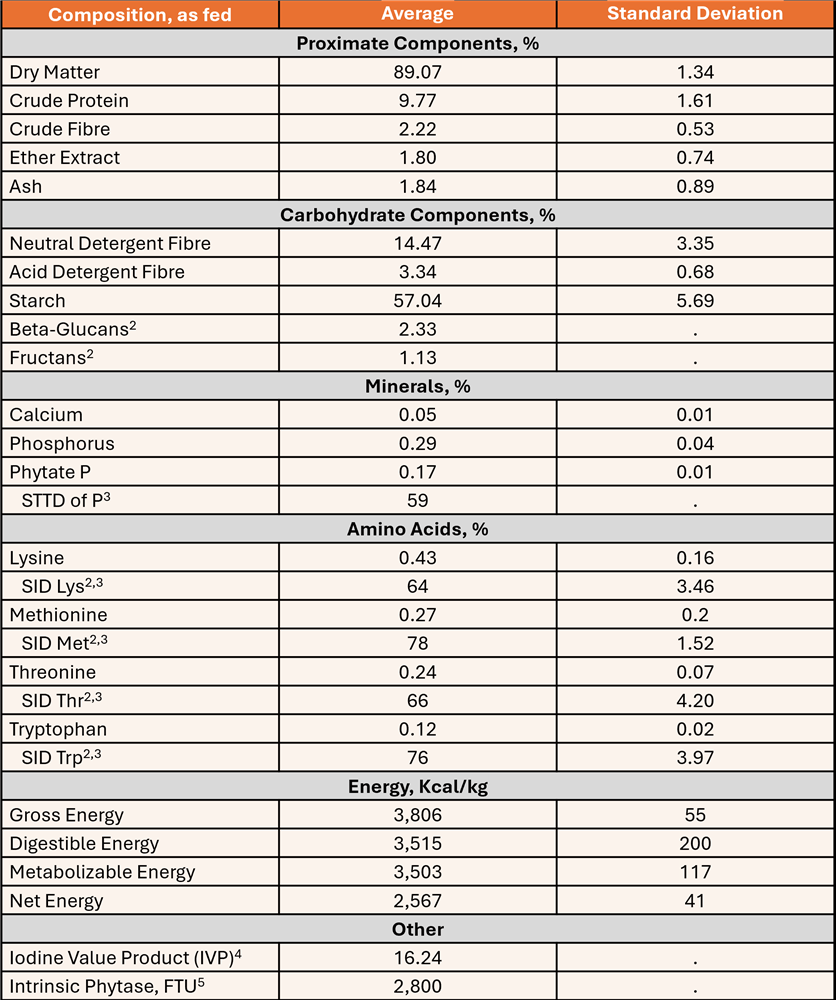
1 Unless otherwise noted, hybrid rye data was collected from 16 samples used in Canadian Research Trials between 2016-2024 (not all studies reported all values).
2 Data obtained from McGhee and Stein, 2018
3 STTD = standardized total tract digestibility, SID = standardized ileal digestibility
4 Calculated based on reported fat profile in INFRA feed tables, 2024
5 FTU = phytase units per kilogram; McGhee & Stein, 2019
Hybrid Rye Forage for Cattle
KWS Hybrid Rye is a fall seeded, winter-hardy crop that boasts excellent nutritional value and flexibility in forage feeding systems.
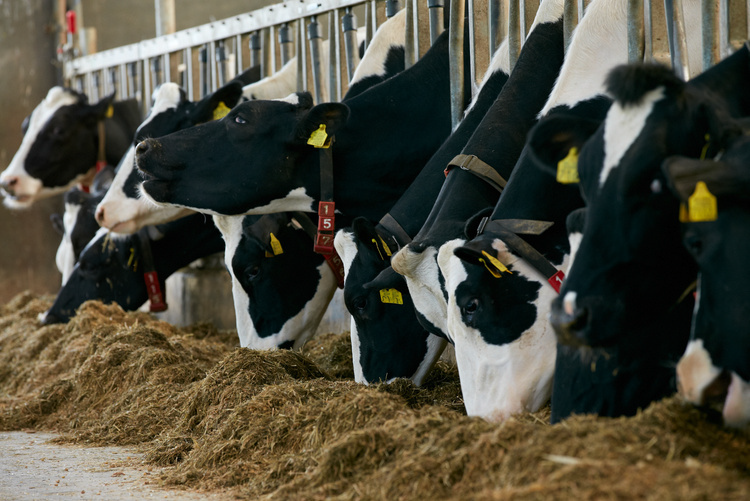
- Highest yielding cereal forage feeds more cows per acre.
- Cutting early maximizes nutritional quality. Cutting late maximizes yield.
- Early cut (flag leaf/boot) is high in energy, nutrient dense and highly digestible, making it an ideal option for cattle requiring a nutrient packed ration.
- Late cut (milk/soft) dough) is higher in fibre with lower energy an nutrien density, making it a great option when reduced energy diets are needed.
- Rich in high quality soluble fibre critical to rumen health and animal performance.
- Provides flexibility for cattle feed ingredients.
- Can be harvested for green feed or silage from flag leaf to milky dough stages.
- Can be harvested as a high-quality feed grain.
- Can be grazed in the fall, spring or after harvest if additional pasture is needed.
- Provides flexibility for cattle operations.
- Earliest maturing cereal forage, providing an opportunity to double crop in southern geographies
- Improves workload management due to different planting and harvest dates.
"We've been growing fall cereals and specifically fall rye for more than 20years. It has given us the flexibility to produce and harvest a high-quality forage crop early in the season and follow up with a secondary cash or greenfeed crop. While seeding a second crop adds a bit of logistics work in the harvest season, it allows us to achieve yields similar to corn silage and helps mitigate hail risk and the winter cereal acts as a very effective cover crop for erosion control. Winter cereal will continue to play a significant role in our operations, allowing us to spread out harvest windows, reduce herbicide usage and minimize the impact of erosion in our withdy Southern Alberta climate."
- Jordan Kolk | Kolk Farms Ltd.

Nutrient Composition of Hybrid Rye*
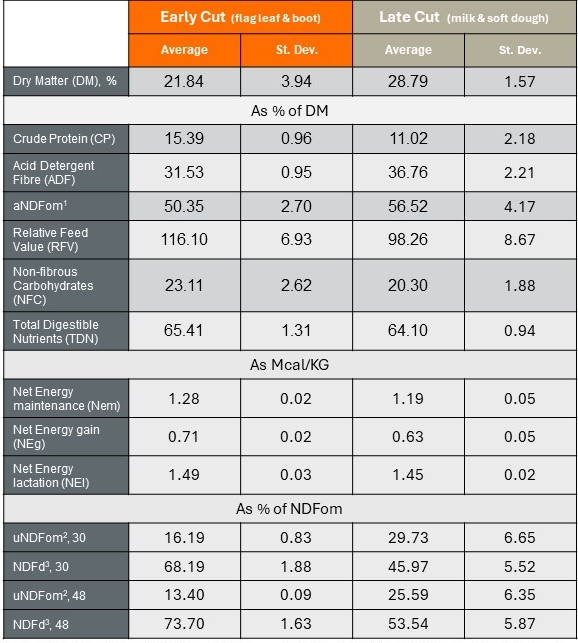
*Data obtained from 2022 and 2023 US Forage Studies covering Northeast, South Central, Midwest and Pacific Northwest
regions. 2023 KWS Hybrid Rye Trial Booklet by KWS.US - Issu
regions. 2023 KWS Hybrid Rye Trial Booklet by KWS.US - Issu
1aNDFom is the Neutral Detergent Fibre on an organic matter basis (ash-free)
2uNDFom is the undisgested NDF fraction on an organic matter basis after the timepoint specified (hours)
3NDFd regers to the digestibility of NDF after the specified time period (hours)
.png)
1All values adjusted to 35% dry matter yield
2Early cut taken at the flag leag to boot stage, late cut taken at the milty to soft dough stage.
3Source: Third party USA rye trials located in Kansas City KS, Scandia KS, Cornell University NY, South Dakota State University SD, 2021-2022
| Juel Scott Territory Manager- Western Prairies 825.288.8861 Juel.scott@kws.com |
Dan Bolton Territory Manager – Eastern Prairies 204.595.9154 daniel.bolton@kws.com |
Laura Eastwood, Ph.D. Animal Nutrition Manager 368.999.1790 laura.eastwood@kws.com |
Learn More about KWS Seeds Canada
• Hybrid Rye varieties
• Location of retail partners
• Cover+ end use market opportunity
• Agronomy Information
• Internal and external programming
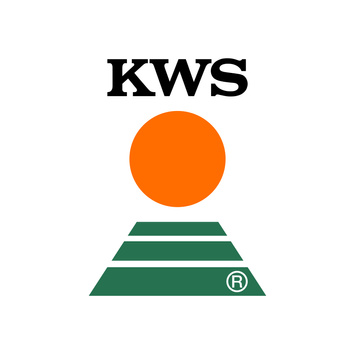
Sign up to stay connected
- News
- Property Alerts
- Save your favourite properties
- And more!
Joining Farm Marketer is free, easy and you can opt out at any time.
